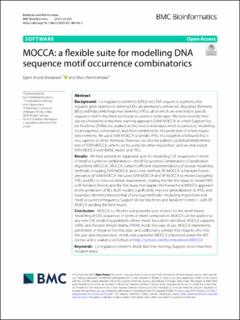MOCCA: a fexible suite for modelling DNA sequence motif occurrence combinatorics
Journal article, Peer reviewed
Published version

Åpne
Permanent lenke
https://hdl.handle.net/11250/2979875Utgivelsesdato
2021Metadata
Vis full innførselSamlinger
- Department of Informatics [928]
- Registrations from Cristin [9791]
Sammendrag
Background
Cis-regulatory elements (CREs) are DNA sequence segments that regulate gene expression. Among CREs are promoters, enhancers, Boundary Elements (BEs) and Polycomb Response Elements (PREs), all of which are enriched in specific sequence motifs that form particular occurrence landscapes. We have recently introduced a hierarchical machine learning approach (SVM-MOCCA) in which Support Vector Machines (SVMs) are applied on the level of individual motif occurrences, modelling local sequence composition, and then combined for the prediction of whole regulatory elements. We used SVM-MOCCA to predict PREs in Drosophila and found that it was superior to other methods. However, we did not publish a polished implementation of SVM-MOCCA, which can be useful for other researchers, and we only tested SVM-MOCCA with IUPAC motifs and PREs.
Results
We here present an expanded suite for modelling CRE sequences in terms of motif occurrence combinatorics—Motif Occurrence Combinatorics Classification Algorithms (MOCCA). MOCCA contains efficient implementations of several modelling methods, including SVM-MOCCA, and a new method, RF-MOCCA, a Random Forest–derivative of SVM-MOCCA. We used SVM-MOCCA and RF-MOCCA to model Drosophila PREs and BEs in cross-validation experiments, making this the first study to model PREs with Random Forests and the first study that applies the hierarchical MOCCA approach to the prediction of BEs. Both models significantly improve generalization to PREs and boundary elements beyond that of previous methods—including 4-spectrum and motif occurrence frequency Support Vector Machines and Random Forests—, with RF-MOCCA yielding the best results.
Conclusion
MOCCA is a flexible and powerful suite of tools for the motif-based modelling of CRE sequences in terms of motif composition. MOCCA can be applied to any new CRE modelling problems where motifs have been identified. MOCCA supports IUPAC and Position Weight Matrix (PWM) motifs. For ease of use, MOCCA implements generation of negative training data, and additionally a mode that requires only that the user specifies positives, motifs and a genome. MOCCA is licensed under the MIT license and is available on Github at https://github.com/bjornbredesen/MOCCA.
